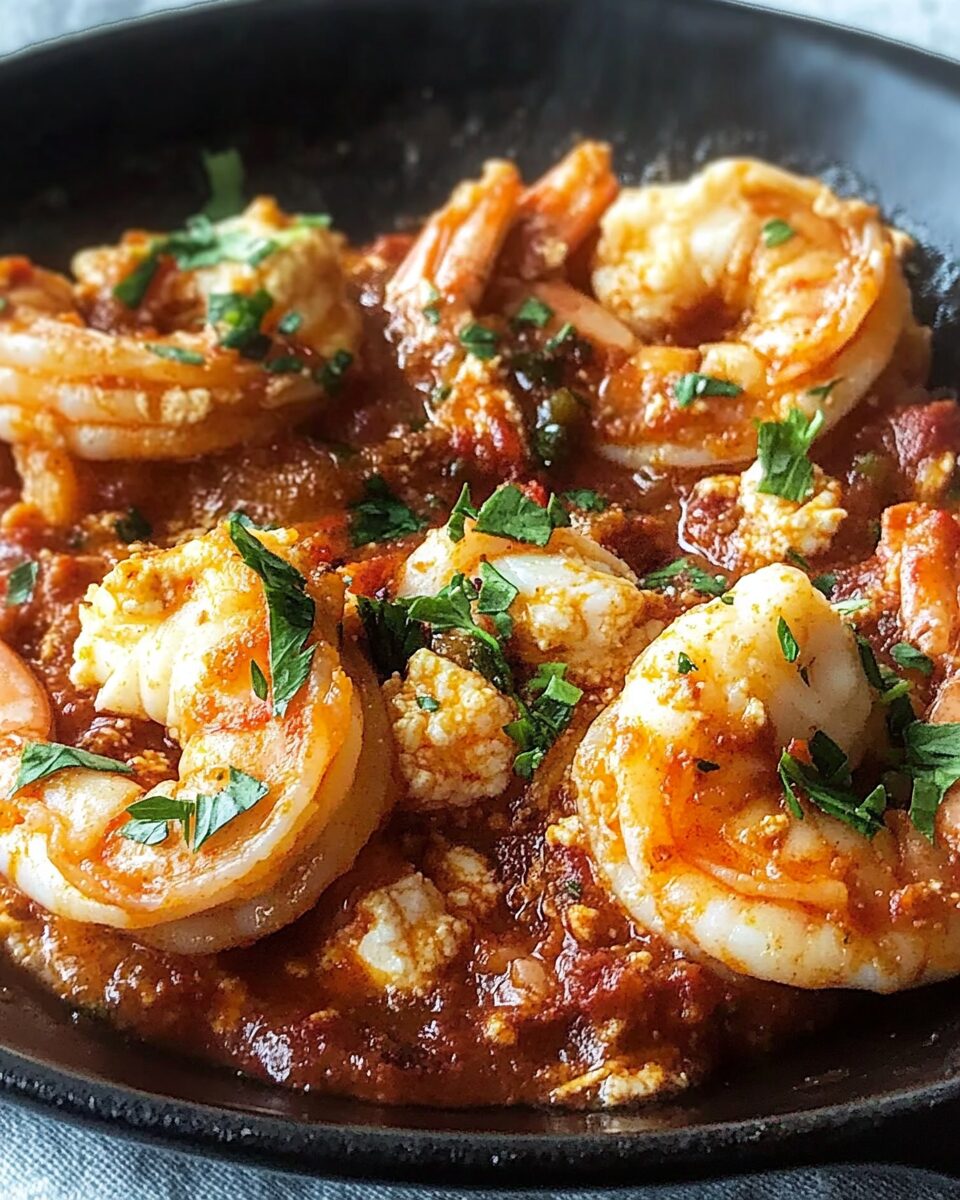Prawn Saganaki is a classic Greek dish that combines succulent prawns with a rich tomato sauce and creamy feta cheese. Traditionally served as an appetizer, it showcases the vibrant flavors of Mediterranean cuisine and is perfect for seafood lovers.
Full Recipe:
Ingredients
- 1 tablespoon olive oil
- 1 red onion, halved and thinly sliced
- 3 cloves garlic, thinly sliced
- 2 tablespoons tomato paste
- ½ cup white wine
- 1 (13.5-ounce) jar tomato and olive pasta sauce
- 1½ pounds prawns, peeled and deveined, tails on
- ½ cup crumbled Greek feta cheese
Directions
-
Sauté Aromatics: Heat olive oil in a skillet over medium heat. Add sliced red onion and cook until translucent, about 5 minutes. Stir in sliced garlic and cook for an additional minute.
-
Incorporate Tomato Base: Add tomato paste to the skillet, stirring continuously for 2 minutes. Pour in white wine, allowing it to simmer and reduce slightly.
-
Add Sauce: Mix in the tomato and olive pasta sauce, bringing the mixture to a gentle simmer.
-
Cook Prawns: Place prawns into the sauce, ensuring they are submerged. Cook until prawns turn pink and are cooked through, approximately 5 minutes.
-
Add Feta: Sprinkle crumbled feta cheese over the prawns and sauce. Cover the skillet and let it cook until the feta softens, about 2 minutes.
-
Serve: Remove from heat and serve warm, garnished with fresh herbs if desired.
Nutritional Facts (Per Serving)
- Calories: Approximately 300 kcal
- Total Fat: 12g
- Saturated Fat: 4g
- Cholesterol: 220mg
- Sodium: 850mg
- Total Carbohydrate: 10g
- Dietary Fiber: 2g
- Sugars: 5g
- Protein: 35g
Historical and Cultural Significance
The origins of Saganaki dishes can be traced back to Greece’s long history of cooking with simple, fresh ingredients that highlight the flavors of the Mediterranean. The method of cooking seafood in a small skillet, or “saganaki,” reflects the regional emphasis on fresh, local ingredients, as well as the practicality of cooking in small portions for the family table. The inclusion of feta cheese in many Saganaki dishes is a nod to Greece’s love for dairy, particularly the iconic Greek feta, which has been made for centuries in the country’s many rural regions.
Prawn Saganaki is not just a dish—it’s a reflection of Greece’s culinary culture, where fresh seafood, cheese, and simple seasonings are key components of many meals. This dish is particularly popular along the coast of Greece, where prawns and other seafood are abundant. It’s a dish that brings the flavors of the sea into the kitchen, combining the delicate sweetness of prawns with the boldness of Greek spices, tomatoes, and feta cheese. While it is often enjoyed as an appetizer, it can also serve as a light main course, especially when paired with crusty bread or a side of vegetables.
The Role of Seafood in Greek Cuisine
Seafood has always played a significant role in Greek cuisine, thanks to the country’s extensive coastline and rich maritime history. The Mediterranean Sea is home to a wide variety of seafood, and prawns, in particular, are highly prized for their tender texture and delicate flavor. The tradition of using seafood in Greek cooking goes back centuries, and dishes like prawn saganaki are a perfect example of how the Greeks have learned to elevate simple, fresh ingredients to create complex, delicious meals.
In Greek culinary culture, seafood dishes are often prepared with minimal ingredients to allow the natural flavors of the seafood to shine through. This approach is evident in prawn saganaki, where the prawns are cooked in a sauce made from tomatoes, garlic, olive oil, and spices, all designed to complement the delicate flavor of the prawns without overpowering them. Feta cheese is often added for its rich, tangy flavor, which pairs beautifully with the sweet, briny taste of the prawns.
Seafood dishes like prawn saganaki are typically served as part of a larger meal, with various side dishes such as rice, salad, or bread to balance the richness of the main dish. The communal nature of Greek meals, where several dishes are served at once and shared among family and friends, adds to the enjoyment of eating prawn saganaki. Whether served at a casual family dinner or a festive gathering, this dish is sure to be a crowd-pleaser.
Health Benefits of Prawn Saganaki
Prawn Saganaki offers several health benefits, making it a great choice for those looking for a meal that is both delicious and nutritious. Prawns are an excellent source of protein, providing all the essential amino acids that the body needs to build and repair tissues. They are also low in fat, making them a heart-healthy option compared to other types of meat. Prawns are rich in vitamins and minerals, including B vitamins, which are essential for energy production, as well as minerals like selenium, iodine, and zinc, which support immune function and overall health.
The use of olive oil in prawn saganaki adds a healthy dose of monounsaturated fats, which are known to improve cholesterol levels and reduce the risk of heart disease. Olive oil is a staple in Mediterranean cuisine and is often used as a base for cooking, offering both flavor and health benefits. Tomatoes, another key ingredient in the dish, are high in antioxidants, particularly lycopene, which is known for its anti-inflammatory properties and its potential to reduce the risk of certain chronic diseases.
The addition of feta cheese provides calcium and vitamin D, both of which are important for bone health. While feta cheese is rich in fat, it is made from sheep’s or goat’s milk, which contains a higher percentage of healthy fats compared to cow’s milk. When consumed in moderation, feta cheese adds a creamy richness to prawn saganaki without compromising the overall healthiness of the dish. Together, these ingredients make prawn saganaki a well-rounded, flavorful, and nutritious meal.
Cooking Tips and Variations
Prawn Saganaki is a versatile dish that can be easily customized to suit personal preferences. While the classic recipe calls for prawns, it can also be made with other types of seafood, such as shrimp, lobster, or mussels. The sauce can be adjusted in terms of flavor and heat by adding more garlic, chili flakes, or herbs like oregano and thyme. Some variations of prawn saganaki even include a splash of ouzo, a traditional Greek anise-flavored liqueur, to add an extra layer of depth to the sauce.
For those who prefer a milder dish, the feta cheese can be omitted or replaced with a lighter cheese, such as ricotta or goat cheese, which still provides a creamy texture without being as rich or tangy. The level of spiciness can also be adjusted depending on personal taste, allowing for a dish that is either mild and comforting or bold and fiery.
The dish can also be made with vegetables for a more substantial meal. Adding roasted red peppers, zucchini, or eggplant to the dish enhances the flavor and texture while still keeping the dish light and fresh. The vegetables can be cooked in the same pan as the prawns, allowing the flavors to meld together and create a well-balanced meal.
Pairing and Serving Suggestions
Prawn Saganaki is best served with a variety of accompaniments that complement its rich, savory flavor. A simple Greek salad made with tomatoes, cucumbers, olives, and red onions provides a refreshing contrast to the warm, hearty prawns. For a more substantial meal, serve prawn saganaki with crusty bread or pita, which can be used to soak up the flavorful sauce.
Another excellent pairing is a side of roasted or steamed vegetables, such as asparagus or green beans, which add freshness and color to the meal. For a more indulgent experience, you can serve prawn saganaki with a side of fluffy rice or orzo, which will help balance the richness of the dish.
When it comes to drinks, a crisp white wine, such as a Sauvignon Blanc or an Assyrtiko, is the perfect choice to complement the flavors of prawn saganaki. If you prefer something non-alcoholic, a chilled glass of sparkling water with a slice of lemon will provide a refreshing contrast to the richness of the prawns and feta.
Conclusion
Prawn Saganaki is a flavorful and comforting dish that embodies the best of Mediterranean cuisine. Its combination of succulent prawns, tangy feta cheese, and rich tomato sauce makes it a memorable meal that is perfect for any occasion. Whether enjoyed as a light appetizer or as a main course, this dish brings the vibrant flavors of Greece to your table and is sure to impress your guests.






